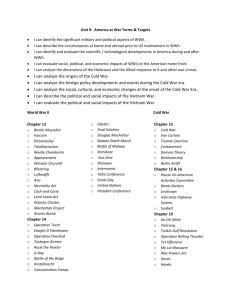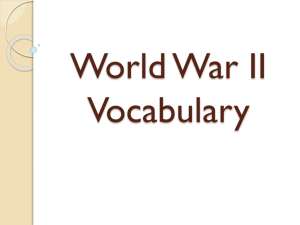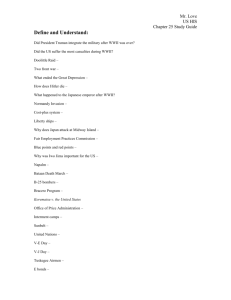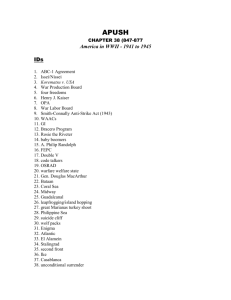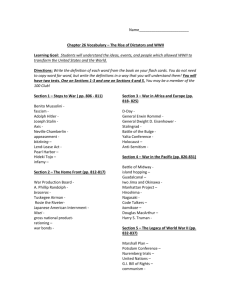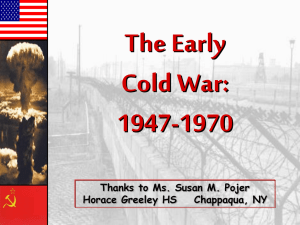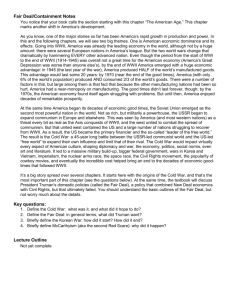Unit 9 Overview/Skeleton Notes
advertisement
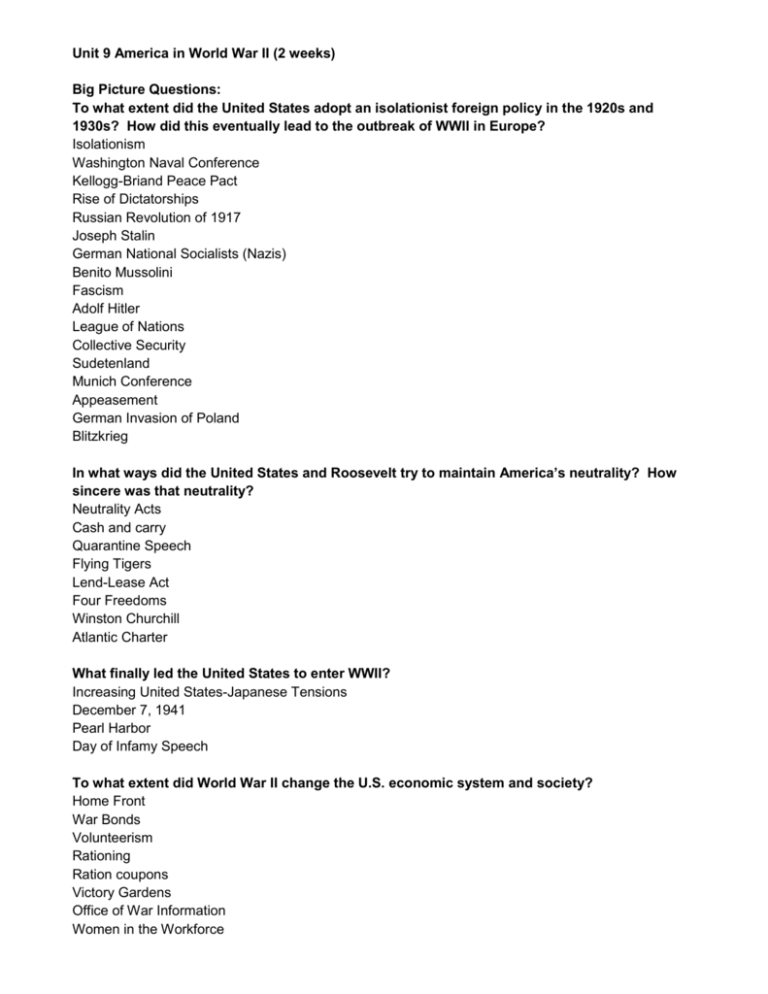
Unit 9 America in World War II (2 weeks) Big Picture Questions: To what extent did the United States adopt an isolationist foreign policy in the 1920s and 1930s? How did this eventually lead to the outbreak of WWII in Europe? Isolationism Washington Naval Conference Kellogg-Briand Peace Pact Rise of Dictatorships Russian Revolution of 1917 Joseph Stalin German National Socialists (Nazis) Benito Mussolini Fascism Adolf Hitler League of Nations Collective Security Sudetenland Munich Conference Appeasement German Invasion of Poland Blitzkrieg In what ways did the United States and Roosevelt try to maintain America’s neutrality? How sincere was that neutrality? Neutrality Acts Cash and carry Quarantine Speech Flying Tigers Lend-Lease Act Four Freedoms Winston Churchill Atlantic Charter What finally led the United States to enter WWII? Increasing United States-Japanese Tensions December 7, 1941 Pearl Harbor Day of Infamy Speech To what extent did World War II change the U.S. economic system and society? Home Front War Bonds Volunteerism Rationing Ration coupons Victory Gardens Office of War Information Women in the Workforce WACS Rosie the Riveter African Americans Tuskegee Airmen Native Americans Mexican Americans Japanese American Internment Executive Order 9066 Korematsu v. U.S. How did the United States and its allies achieve victory in Europe during WWII? Axis powers Allied Powers George Patton D-Day Dwight D. Eisenhower Normandy Omar Bradley Battle of the Bulge Vernon Baker The Holocaust Genocide Final Solution Liberation of the Concentration Camps How did the United States and its allies achieve victory in Asia and the Pacific during WWII? Bataan Death March 1942 Island hopping Navajo code talkers Battle of Midway Chester Nimitz Douglas McArthur George C. Marshall Decision to use the atomic bomb Albert Einstein Harry Truman Atomic bomb Hiroshima Nagasaki What is the legacy of WWII? Radar Sonar Cryptic code breaking Proximity fuse Antibiotics Jet and rocket engines WWII statistics (U.S. deaths, worldwide deaths, wounded etc.) The Nuremberg Trials 1945-46 “Denazification” Division of Germany Occupation of Japan Instructional Focus: This unit starts off discussing how America’s return to isolationism and the rise of dictatorships during the Great Depression led to the start of WWII in Europe. The unit also discusses appeasement attempts and their failure; this would be a great opportunity to pull in some of Dr. Seuss’s political cartoons. The unit then goes on to discuss America’s attempts at neutrality and why we were finally forced into going to war. This provides an opportunity for students to listen and analyze FDR’s Day of Infamy speech. Changes in America on the home front will then take center stage and there are great propaganda posters that can be analyzed and students should be exposed to some of these primary sources as they are often used on state testing. We then focus on how the war was won in both Europe and Asia. Special attention should be given to the decision to use the atomic bomb and the moral dilemma facing the United States and Harry Truman and this topic would make a great writing assignment providing the students the opportunity to support a position on a social studies issue. WWII had a lasting legacy and care should be taken that students understand these. Lil’ Hitler clip Chicken Robot http://www.youtube.com/watch?v=9-axJTzj0VU Suggested Resources: Dr. Seuss political cartoons: http://bank.imgdumpr.com/index.php/random/real-political-cartoons-by-drseuss-during-wwii-30-pics/ National Geographic video comparing/contrasting the movie “Pearl Harbor” with actual events. FDR: Audio and text of Day of Infamy speech Documentary of Tuskegee Airmen Documentary of Navajo Codebreakers
